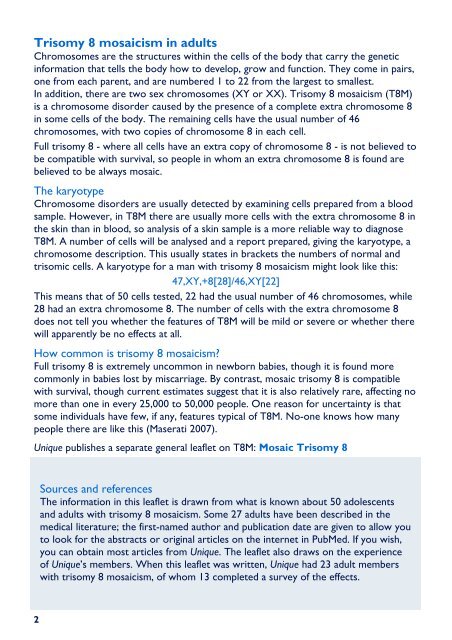Trisomy 8 mosaicism in adults FTNW.pub - Unique - The Rare ...
Trisomy 8 mosaicism in adults FTNW.pub - Unique - The Rare ...
Trisomy 8 mosaicism in adults FTNW.pub - Unique - The Rare ...
Create successful ePaper yourself
Turn your PDF publications into a flip-book with our unique Google optimized e-Paper software.
<strong>Trisomy</strong> 8 <strong>mosaicism</strong> <strong>in</strong> <strong>adults</strong><br />
Chromosomes are the structures with<strong>in</strong> the cells of the body that carry the genetic<br />
<strong>in</strong>formation that tells the body how to develop, grow and function. <strong>The</strong>y come <strong>in</strong> pairs,<br />
one from each parent, and are numbered 1 to 22 from the largest to smallest.<br />
In addition, there are two sex chromosomes (XY or XX). <strong>Trisomy</strong> 8 <strong>mosaicism</strong> (T8M)<br />
is a chromosome disorder caused by the presence of a complete extra chromosome 8<br />
<strong>in</strong> some cells of the body. <strong>The</strong> rema<strong>in</strong><strong>in</strong>g cells have the usual number of 46<br />
chromosomes, with two copies of chromosome 8 <strong>in</strong> each cell.<br />
Full trisomy 8 - where all cells have an extra copy of chromosome 8 - is not believed to<br />
be compatible with survival, so people <strong>in</strong> whom an extra chromosome 8 is found are<br />
believed to be always mosaic.<br />
<strong>The</strong> karyotype<br />
Chromosome disorders are usually detected by exam<strong>in</strong><strong>in</strong>g cells prepared from a blood<br />
sample. However, <strong>in</strong> T8M there are usually more cells with the extra chromosome 8 <strong>in</strong><br />
the sk<strong>in</strong> than <strong>in</strong> blood, so analysis of a sk<strong>in</strong> sample is a more reliable way to diagnose<br />
T8M. A number of cells will be analysed and a report prepared, giv<strong>in</strong>g the karyotype, a<br />
chromosome description. This usually states <strong>in</strong> brackets the numbers of normal and<br />
trisomic cells. A karyotype for a man with trisomy 8 <strong>mosaicism</strong> might look like this:<br />
47,XY,+8[28]/46,XY[22]<br />
This means that of 50 cells tested, 22 had the usual number of 46 chromosomes, while<br />
28 had an extra chromosome 8. <strong>The</strong> number of cells with the extra chromosome 8<br />
does not tell you whether the features of T8M will be mild or severe or whether there<br />
will apparently be no effects at all.<br />
How common is trisomy 8 <strong>mosaicism</strong>?<br />
Full trisomy 8 is extremely uncommon <strong>in</strong> newborn babies, though it is found more<br />
commonly <strong>in</strong> babies lost by miscarriage. By contrast, mosaic trisomy 8 is compatible<br />
with survival, though current estimates suggest that it is also relatively rare, affect<strong>in</strong>g no<br />
more than one <strong>in</strong> every 25,000 to 50,000 people. One reason for uncerta<strong>in</strong>ty is that<br />
some <strong>in</strong>dividuals have few, if any, features typical of T8M. No-one knows how many<br />
people there are like this (Maserati 2007).<br />
<strong>Unique</strong> <strong>pub</strong>lishes a separate general leaflet on T8M: Mosaic <strong>Trisomy</strong> 8<br />
Sources and references<br />
<strong>The</strong> <strong>in</strong>formation <strong>in</strong> this leaflet is drawn from what is known about 50 adolescents<br />
and <strong>adults</strong> with trisomy 8 <strong>mosaicism</strong>. Some 27 <strong>adults</strong> have been described <strong>in</strong> the<br />
medical literature; the first-named author and <strong>pub</strong>lication date are given to allow you<br />
to look for the abstracts or orig<strong>in</strong>al articles on the <strong>in</strong>ternet <strong>in</strong> PubMed. If you wish,<br />
you can obta<strong>in</strong> most articles from <strong>Unique</strong>. <strong>The</strong> leaflet also draws on the experience<br />
of <strong>Unique</strong>’s members. When this leaflet was written, <strong>Unique</strong> had 23 adult members<br />
with trisomy 8 <strong>mosaicism</strong>, of whom 13 completed a survey of the effects.<br />
2

















